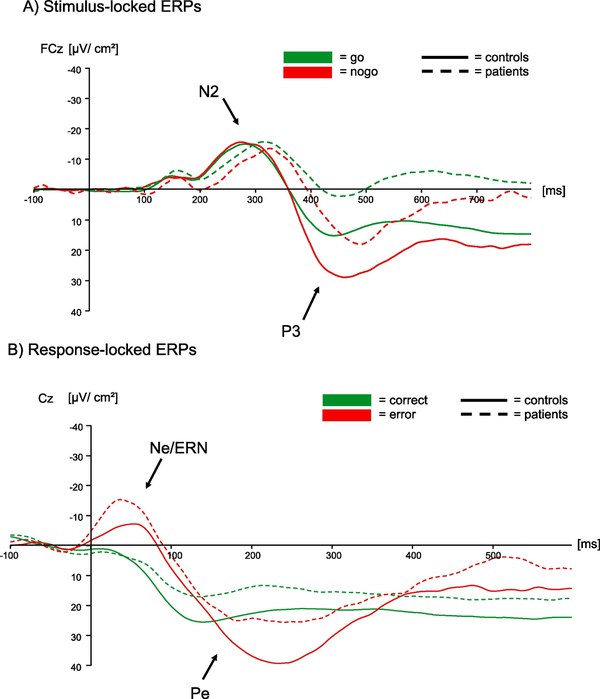Preserved performance monitoring and error detection in left hemisphere stroke
Depending on the lesion site, a stroke typically affects various aspects of cognitive control. While executing a task, the performance monitoring system constantly compares an intended action plan with the executed action and thereby registers inaccurate actions in case of any mismatch. When errors occur, the performance monitoring system signals the need for more cognitive control, which is most efficient when the subject notices errors rather than processing them subconsciously.
The current study aimed to investigate performance monitoring and error detection in a large sample of patients with left hemisphere (LH) stroke. In addition to clinical and neuropsychological tests, 24 LH stroke patients and 32 healthy age-matched controls performed a Go/Nogo task with simultaneous electroencephalography (EEG) measurements. This set-up enabled us to compare performance monitoring at the behavioral and the neural level.
EEG data were analyzed using event-related potentials [ERPs; e.g., the error-related negativity (Ne/ERN) and error positivity (Pe)] and additionally more sensitive whole-brain multivariate pattern classification analyses (MVPA).
We hypothesized that LH stroke patients would show behavioural deficits in error detection when compared to healthy controls, mirrored by differences in neural signals, in particular reflected in the Pe component.
Interestingly, despite clinically relevant cognitive deficits (e.g., aphasia and apraxia) including executive dysfunction (trail making test), we did not observe any behavioral impairments related to performance monitoring and error processing in the current LH stroke patients (Fig. 1).

Patients also showed similar results for Ne/ERN and Pe components, compared to the control group (Fig. 2), and a highly similar prediction of errors from multivariate signals. ERP abnormalities during stimulus processing (i.e., N2 and P3) demonstrated the specificity of these findings in the current LH stroke patients.
In contrast to previous studies, by employing a relatively large patient sample, a well-controlled experimental paradigm with a standardized error signaling procedure, and advanced data analysis, we were able to show that performance monitoring (of simple actions) is a preserved cognitive control function in LH stroke patients that might constitute a useful resource in rehabilitative therapies for relearning impeded functions.

Publication:
Niessen, E., Ant, J. M., Bode, S., Saliger, J., Karbe, H., Fink, G. R., Stahl, J., & Weiss, P. H. (2020). Preserved performance monitoring and error detection in left hemisphere stroke. NeuroImage: Clinical 27, 102307.
